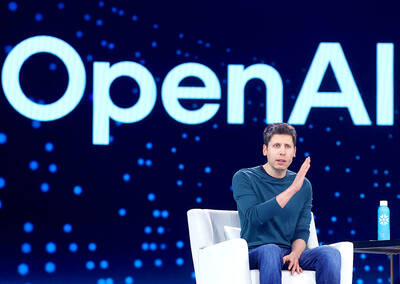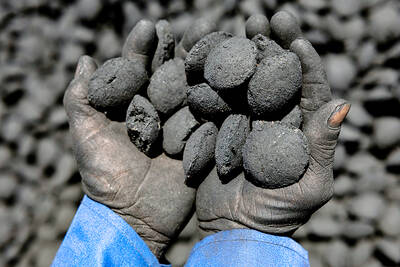A new vineyard worker is looking for a job in France. White with red trim, 50cm tall and 60cm wide, he has four wheels, two arms and six cameras, prunes 600 vines per day and never calls in sick.
The Wall-Ye V.I.N. robot, brainchild of Burgundy-based inventor Christophe Millot, is one of the robots being developed around the world aimed at vineyards struggling to find the labor they need.
It takes on labor-intensive chores likes pruning and de-suckering — removing unproductive young shoots — while collecting valuable data on the health and vigor of the soil, fruit and vine stocks.

Photo: AFP
Sales demonstrations of the 20kg robot are about to begin.
Wall-Ye draws on tracking technology, artificial intelligence and mapping to move from vine to vine, recognize plant features, capture and record data, memorize each vine, synchronize six cameras and guide its arms to wield tools.
An in-built security mechanism is designed to thwart would-be robot snatchers.
“It has a GPS, and if it finds itself in a non-designated vineyard, it won’t start. It also has a gyroscope so it knows if it’s been lifted off the ground,” Millot said.
“If that happens, the hard drive self-destructs and the robot sends a message to the winegrower: ‘Help!’” he said.
Millot’s inspiration came from a frustrated winegrower, Denis Fetzmann, estate manager at Domaine Louis Latour, while on a tour of his vineyards in France’s southeastern Ardeche region.
“He needed to thin the leaves, because the clusters were too big and they didn’t dare use a machine — but they couldn’t find workers. It was August and everyone was on holiday. I told him I’d make him a robot,” Millot said.
It took three years to do so.
“Honestly, it was thousands of hours of work for the two of us — weekends and nights,” said Guy Julien, the toolmaker who partnered Millot to manufacture the robot.
“The biggest challenge was to make the cameras understand what they are seeing and how to interpret it,” Millot said.
Demos using a prototype have already sparked a buzz in winemaker circles.
Excited vintners have rung up Millot with a list of tasks they’d like to delegate.
“Every winegrower asks for different things,” the inventor said. “In Alsace, for example, they wanted de-suckering with a simple knife to clean up the tops of the Gewurztraminer.”
The price tag for the Wall-Ye robot is set at 25,000 euros (US$32,000), the same as a medium-size car.
“Which isn’t bad considering it works day and night, even Sundays, doesn’t take holidays or stop for a snack,” Julien said.
“If I have the choice between the robot and the employee, I’ll take the robot — it’s less expensive and less trouble,” said Patricia Chabrol, owner of Chateau Gerbaud in Saint Emilion, who has seen Wall-Ye at work.
“We have robots in factories, robots that take care of the elderly — I think we can do some very high quality work with this vineyard robot,” she said.
And what of concerns the robot could destroy jobs at a time when French unemployment stands at 3 million?
“Obviously this means we’ll cut the job for vineyard pruners, but we’re creating jobs for someone who has gone to school and who will build, maintain and improve the robots,” Julien said. “And we’re going to keep the manufacturing in France.”
Wall-Ye is one of a handful of similar projects under development in the wine world. Both California and New Zealand are developing intelligent vision-based pruning robots.
Richard Green of the University of Canterbury is developing a pruning robot backed by French drinks giant Pernod Ricard. He predicts it will save the New Zealand wine industry 17.6 million euros per year through increased productivity and reduced yield losses.
“But it’s not just about labor costs, it’s about the quality of the pruning. We often have novice pruners who have to be trained each year,” Green said.
In California, Vision Robotics founder Bret Wallach said their robotic vine pruner, still in test phase, is 3m tall with eight cameras, and pairs a 3D model of the vines with customized pruning rules.
“It’s the same rules you would give a manual crew,” Wallach said.
However, manual crews are growing scarce in California.
“And it gets worse every year,” he said.
Labor issues aside, some French growers are unwilling to see robotic pruners industrialize what has historically been a craft-based product.
“Technically it’s interesting, but intellectually, it’s inconceivable. It doesn’t fit with my philosophy of making a Saint Emilion grand cru,” Chateau du Val d’Or owner Philippe Bardet said.
“I’m all for automating certain tasks, but not pruning,” he said.
Pruning is a particularly sensitive task because it tells the vine how many bunches of grapes to produce and affects its ability to ripen the fruit to perfection.
“Each plant is unique in terms of things like vigor, so it must be treated uniquely during pruning,” Fetzmann said.
“But I can see a robot doing the pre-pruning in November, and humans finishing in March. A machine like this could be really useful stocking data about each individual vine stock, adapting treatments to the diversity in vegetation and soil even within a plot,” he said.

DIVIDED VIEWS: Although the Fed agreed on holding rates steady, some officials see no rate cuts for this year, while 10 policymakers foresee two or more cuts There are a lot of unknowns about the outlook for the economy and interest rates, but US Federal Reserve Chair Jerome Powell signaled at least one thing seems certain: Higher prices are coming. Fed policymakers voted unanimously to hold interest rates steady at a range of 4.25 percent to 4.50 percent for a fourth straight meeting on Wednesday, as they await clarity on whether tariffs would leave a one-time or more lasting mark on inflation. Powell said it is still unclear how much of the bill would fall on the shoulders of consumers, but he expects to learn more about tariffs

NOT JUSTIFIED: The bank’s governor said there would only be a rate cut if inflation falls below 1.5% and economic conditions deteriorate, which have not been detected The central bank yesterday kept its key interest rates unchanged for a fifth consecutive quarter, aligning with market expectations, while slightly lowering its inflation outlook amid signs of cooling price pressures. The move came after the US Federal Reserve held rates steady overnight, despite pressure from US President Donald Trump to cut borrowing costs. Central bank board members unanimously voted to maintain the discount rate at 2 percent, the secured loan rate at 2.375 percent and the overnight lending rate at 4.25 percent. “We consider the policy decision appropriate, although it suggests tightening leaning after factoring in slackening inflation and stable GDP growth,”

Meta Platforms Inc offered US$100 million bonuses to OpenAI employees in an unsuccessful bid to poach the ChatGPT maker’s talent and strengthen its own generative artificial intelligence (AI) teams, OpenAI CEO Sam Altman has said. Facebook’s parent company — a competitor of OpenAI — also offered “giant” annual salaries exceeding US$100 million to OpenAI staffers, Altman said in an interview on the Uncapped with Jack Altman podcast released on Tuesday. “It is crazy,” Sam Altman told his brother Jack in the interview. “I’m really happy that at least so far none of our best people have decided to take them

As they zigzagged from one machine to another in the searing African sun, the workers were covered in black soot. However, the charcoal they were making is known as “green,” and backers hope it can save impoverished Chad from rampant deforestation. Chad, a vast, landlocked country of 19 million people perched at the crossroads of north and central Africa, is steadily turning to desert. It has lost more than 90 percent of its forest cover since the 1970s, hit by climate change and overexploitation of trees for household uses such as cooking, officials say. “Green charcoal” aims to protect what